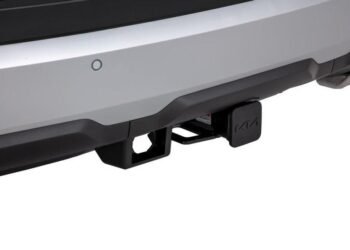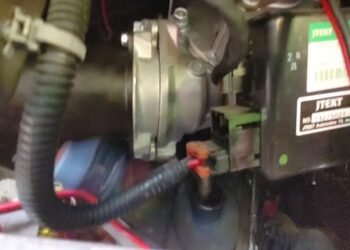When it comes to securing your flywheel bolts, you might wonder if using Loctite is really necessary. You want your engine to run smoothly and safely without the risk of bolts loosening over time due to vibration and heat.
Applying Loctite on flywheel bolts can be a simple yet effective step to keep everything firmly in place. But how do you choose the right type? And what’s the best way to apply it without causing damage or making future maintenance a headache?
You’ll discover why Loctite matters for your flywheel bolts, which options work best, and how to apply it correctly for peace of mind every time you hit the road. Keep reading to protect your engine’s heart with confidence.
Benefits Of Loctite On Flywheel Bolts
Applying Loctite on flywheel bolts offers several key benefits that improve engine reliability and safety. It enhances the fastening strength and prevents common issues caused by engine stress. These advantages help maintain the proper function of your vehicle over time.
Preventing Loosening From Vibration
Flywheel bolts face constant vibration from the engine. Loctite acts as a thread locker, keeping the bolts tightly secured. It stops bolts from backing out or loosening during normal engine operation. This reduces the risk of damage and costly repairs.
Heat Cycle Resistance
Engines go through many heat cycles, heating up and cooling down repeatedly. Loctite formulas designed for high temperatures resist breakdown under these conditions. This ensures the flywheel bolts stay firmly in place even after long periods of engine use.
Corrosion Protection
Moisture and road salt can cause corrosion on flywheel bolts. Loctite seals the threads, blocking moisture and preventing rust. This protection extends the life of the bolts and keeps them easier to remove if needed later.
Choosing The Right Loctite
Choosing the right Loctite for flywheel bolts is crucial. Flywheel bolts face constant vibration and heat. This can cause bolts to loosen over time. Using the correct Loctite keeps bolts tight and secure. It also prevents damage and ensures engine safety. Different types of Loctite offer various strengths and features. Understanding these options helps pick the best product for your needs.
High-strength Options
High-strength Loctite is best for heavy-duty use. It resists strong vibrations and extreme heat well. This type locks bolts firmly in place. It prevents any chance of loosening during engine operation. Removing bolts sealed with high-strength Loctite usually requires heat. Use this only when you do not plan to remove bolts often.
Medium-strength Alternatives
Medium-strength Loctite offers solid holding power. It is perfect for most flywheel bolt applications. This type holds bolts firmly but allows removal with hand tools. Mechanics favor it for repairs and routine maintenance. It balances strong hold with easier bolt removal. Medium strength is a reliable choice for many users.
Hybrid Formulas
Hybrid Loctite formulas blend strength and flexibility. They provide stronger hold than medium types. At the same time, they allow easier removal than high-strength ones. These products often come in unique colors like orange. Hybrid Loctite suits users needing a strong but serviceable bond. It works well for flywheel bolts under moderate stress.
Preparation Before Application
Proper preparation is essential before applying Loctite on flywheel bolts. It ensures the threadlocker bonds well and holds the bolts securely. Skipping preparation can lead to loosening or failure due to vibrations and heat changes.
Take time to clean and prepare the threads and surfaces carefully. This step improves adhesion and prevents contamination.
Cleaning Threads And Surfaces
Start by removing old threadlocker or rust from the flywheel bolts. Use a wire brush or thread cleaning tool for best results. Clean the mating surfaces where the bolts will sit. Dirt or corrosion can weaken the bond and cause slipping.
Use a clean rag to wipe the bolts and surfaces. Make sure they are dry before moving to the next step.
Removing Oil And Debris
Oil and grease reduce Loctite’s effectiveness. Use a degreaser or brake cleaner spray on the threads and bolt holes. Spray thoroughly to remove all contaminants.
Allow everything to dry completely. Moisture or leftover debris will prevent the threadlocker from curing properly. Always work in a clean and dust-free area.
Applying Loctite Correctly
Applying Loctite correctly on flywheel bolts ensures a secure hold and prevents loosening. Proper use helps maintain engine performance and safety. It also protects the threads from damage caused by vibration and heat. Follow precise steps for best results when applying Loctite.
Amount To Use
Use a small drop of Loctite on each bolt. Too much can cause excess buildup and mess. A pea-sized amount is enough to cover the threads. Avoid flooding the bolt with liquid. This ensures proper curing and strong bonding.
Placement On Threads
Apply Loctite on the clean, dry threads only. Focus on the middle section of the bolt threads. Do not apply on the bolt head or the part that touches the flywheel surface. Correct placement allows Loctite to fill gaps and lock the bolt firmly.
Installing Flywheel Bolts
Installing flywheel bolts correctly is essential for engine performance and safety. These bolts secure the flywheel to the crankshaft, facing constant vibration and heat. Using Loctite on flywheel bolts helps keep them tight and prevents loosening over time. Proper installation steps ensure the bolts hold firmly and last longer.
Hand-tightening First
Start by threading each flywheel bolt by hand. This avoids cross-threading and ensures proper fit. Turn each bolt slowly until it seats firmly against the flywheel. Hand-tightening helps align the bolts correctly before final torque. Never use power tools at this stage to prevent damage.
Torque Specifications
Use a torque wrench to tighten flywheel bolts to the manufacturer’s specifications. Follow the exact torque value recommended in the service manual. Over-tightening can strip threads or warp the flywheel. Under-tightening risks the bolts loosening during operation. Accurate torque ensures proper clamping force and safety.
Bolt Tightening Pattern
Follow a specific bolt tightening pattern to distribute pressure evenly. Usually, this means tightening bolts in a crisscross or star pattern. Tighten bolts gradually in steps, moving through the pattern multiple times. This method prevents warping and maintains flywheel balance. Proper pattern use helps the bolts seat evenly and firmly.

Credit: www.impactbumpers.com
Using New Vs. Reused Bolts
Using new versus reused bolts on your flywheel is a key decision for safety and performance. Flywheel bolts undergo stress from engine vibration and heat. Reusing old bolts may weaken their hold, risking loosening or failure. Choosing new bolts ensures the best fit and strength. This practice helps maintain engine integrity and prevents costly repairs.
Loctite application also plays a role in bolt security. Proper threadlocker use prevents bolts from vibrating loose. Understanding bolt type and threadlocker options improves installation results.
Oem Bolt Considerations
OEM bolts are made to meet specific engine standards. They have precise thread sizes and materials designed for your flywheel. Reusing OEM bolts can reduce clamping force. Threads may wear or strip from previous use. New OEM bolts provide consistent torque and strength. Always check manufacturer guidelines for bolt reuse rules. Using OEM bolts lowers risk of flywheel damage or engine problems.
Threadlocker Pre-applied Bolts
Some bolts come with threadlocker pre-applied from the factory. This saves time and ensures correct application. The threadlocker is measured to provide optimal holding power. Pre-applied threadlocker bolts reduce the chance of user error. They are convenient for quick, reliable installation. Confirm the threadlocker type suits your engine’s heat and vibration levels. These bolts help maintain secure flywheel attachment over time.
Key Torque Tips
Applying the correct torque on flywheel bolts is crucial for engine safety and performance. Using Loctite on these bolts enhances their hold, but proper torque practices remain key. Follow these tips to secure bolts without damage or loosening.
Torque As Primary Security
Torque ensures bolts stay tight under engine vibration and heat. Loctite acts as a thread locker but cannot replace proper torque. Always tighten bolts to the manufacturer’s specified torque value. This step prevents bolt movement and engine damage. Use a calibrated torque wrench for accuracy. Tightening bolts in the right sequence also distributes stress evenly.
Avoiding Over-tightening
Over-tightening flywheel bolts can cause thread damage or bolt failure. Applying too much torque may distort the flywheel or strip threads. Use the correct torque setting and stop once reached. Avoid guessing or using impact tools for final tightening. If using Loctite, wait for it to cure before re-torquing. Proper care extends bolt life and maintains engine integrity.
Credit: nam3forum.com
Manufacturer Guidelines
Manufacturer guidelines for using Loctite on flywheel bolts are important to follow. These rules help ensure safety and proper function. Flywheel bolts face strong forces and heat. Correct use of Loctite prevents bolts from loosening or failing.
Each vehicle may have specific instructions. Ignoring these can cause damage or unsafe conditions. Understanding these guidelines makes repairs more reliable and longer-lasting.
Consulting Vehicle Manuals
Always check the vehicle manual before applying Loctite. Manuals provide torque specs and bolt treatment advice. They may state if Loctite is needed or not. Using the wrong method can cause bolts to fail.
Manuals also list the type of threadlocker recommended. Following exact steps protects the engine and flywheel. If unsure, trust the manufacturer’s directions over general advice.
Bolt Reusability Rules
Some flywheel bolts are single-use only. Reusing these bolts may lead to weak fastening. Manufacturer guidelines specify if bolts should be replaced. Old bolts can lose strength or thread integrity.
Using new bolts with Loctite ensures a secure hold. This practice reduces the risk of bolt loosening from vibration. Always replace bolts as the manual instructs to maintain safety.
Threadlocker Recommendations
Manufacturers suggest specific Loctite grades for flywheel bolts. Blue Loctite is common for moderate strength and easy removal. Red Loctite offers stronger bonding but needs heat to remove.
Applying the right threadlocker prevents bolt loosening during engine operation. Avoid using excess Loctite to prevent contamination. Follow the manual to choose and apply the correct product.

Credit: www.reddit.com
Frequently Asked Questions
Is Loctite Needed For Flywheel Bolts?
Loctite is recommended on flywheel bolts to prevent loosening from vibration and heat. Use blue or orange threadlocker for easy removal. Always clean threads and torque bolts to manufacturer specs in the correct sequence for secure installation.
Do You Put Loctite On Clutch Bolts?
Yes, apply a small amount of blue or medium-strength Loctite on clutch bolts. It prevents loosening from vibration. Avoid excessive use to ensure proper bolt seating and torque. Always follow the manufacturer’s torque specs for secure installation.
Should You Put Loctite On Wheel Bolts?
Use blue Loctite on wheel bolts to prevent loosening from vibration and moisture. Avoid overusing it and always torque bolts to specs.
Does A Crank Bolt Need Loctite?
Use Loctite on crank bolts in high-vibration or heat conditions to prevent loosening. Clean threads, apply sparingly, then torque properly.
Should I Use Loctite On Flywheel Bolts?
Using Loctite on flywheel bolts helps prevent loosening from vibration and heat cycles.
Conclusion
Using Loctite on flywheel bolts helps keep them tight under stress. It prevents loosening caused by heat and vibration. Always clean threads before applying a small amount of Loctite. Choose the right type based on your needs—blue for easy removal, red for strong hold.
Proper torque and correct sequence remain essential. This simple step adds safety and reliability to your engine.

















